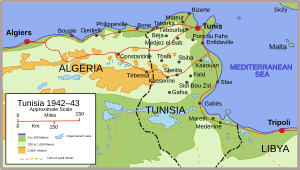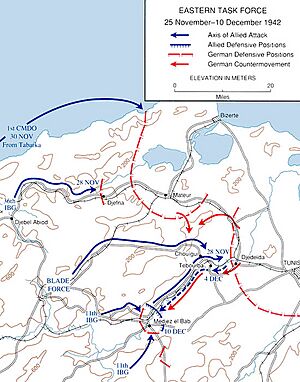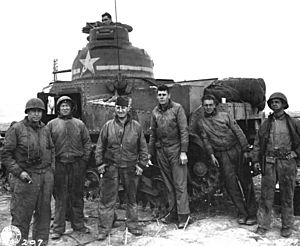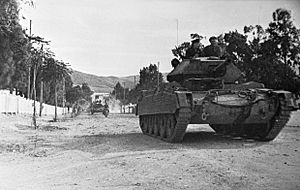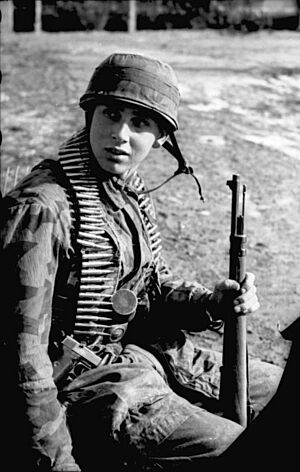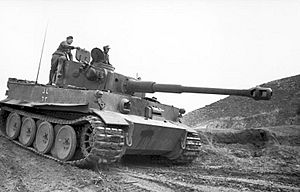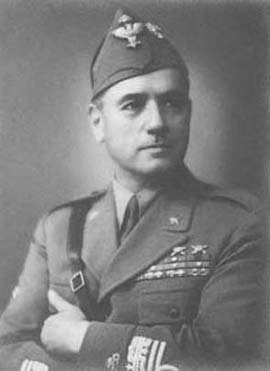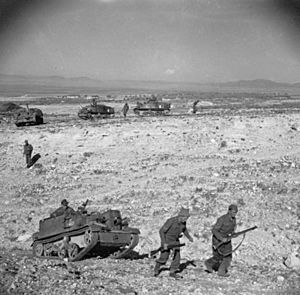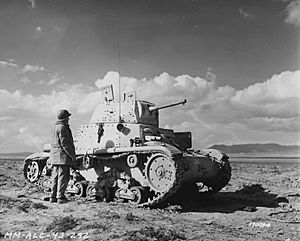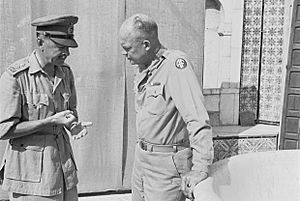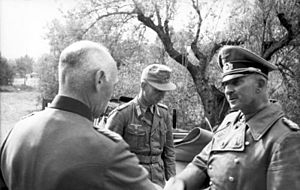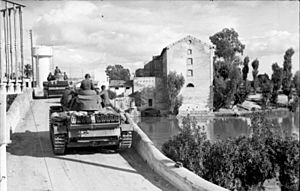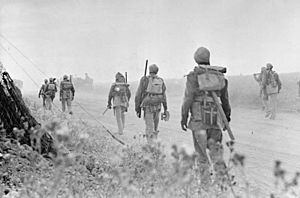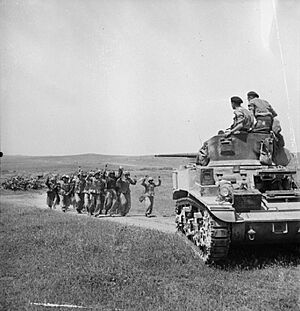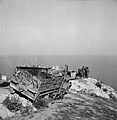Tunisian campaign facts for kids
Quick facts for kids Tunisian campaign |
|||||||||
|---|---|---|---|---|---|---|---|---|---|
| Part of the North African campaign of the Second World War | |||||||||
 German and Italian prisoners of war following the fall of Tunis, 12 May 1943. |
|||||||||
|
|||||||||
| Belligerents | |||||||||
|
|||||||||
| Commanders and leaders | |||||||||
|
|
||||||||
| Strength | |||||||||
| March: 500,000 troops 1,800+ tanks 1,200+ field guns Thousands of aircraft |
March: 350,000 troops 200+ tanks 1,000+ field guns Thousands of aircraft |
||||||||
| Casualties and losses | |||||||||
| 76,020 849 aircraft destroyed 340+ tanks lost |
290,000–362,000 (238,000-300,000 captured) 450+ tanks lost 1,000+ guns captured Thousands of trucks captured |
||||||||
The Tunisian campaign was a series of important battles fought in Tunisia during World War II. It was part of the larger North African campaign. This campaign took place from November 17, 1942, to May 13, 1943. The fighting was between the Axis powers (Germany and Italy) and the Allies of World War II (mainly Britain, the United States, and France).
At first, the German and Italian forces had some success. However, the Allies managed to cut off their supplies. This led to a major defeat for the Axis. Over 250,000 German and Italian soldiers were captured. This included most of the famous Afrika Korps.
Contents
Why Tunisia Was Important
The Desert War Background
For the first two years of the war in North Africa, getting supplies was a huge problem. There were not many good ports on the coast. The main British base was far from the main Italian port. Smaller ports were also very far away.
Both the British and Italian navies fought for control of the central Mediterranean Sea. This made it hard for either side to get supplies. The British could get supplies by sailing all the way around Africa. This was a very long journey.
Because of these supply problems, battles often ended without a clear winner. Armies would advance far, then have to retreat. In 1942, the British Navy and Air Force got better at sinking Italian supply ships. The British also started getting many more supplies from the United States. This helped them push the Axis forces back from Egypt in November 1942.
Operation Torch: Landing in North Africa

In July 1942, the Allies decided to land troops in North Africa. This plan was called Operation Torch. The goal was to take control of French territories like Morocco, Algeria, and Tunisia. Then, they would push east to trap the Axis forces in the desert.
Taking control of the North African coast would open the Mediterranean Sea for Allied ships. This would save a lot of time and resources. On November 8, Allied forces landed in Algeria and Morocco. Their goal was to advance quickly to Tunis, about 500 miles to the east.
Getting Ready for Battle
Allied Plans to Reach Tunis
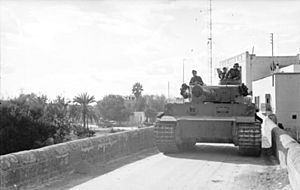
The Allies knew that the Axis would try to take Tunisia as soon as they heard about the landings. So, the Allies needed to get to Tunisia very fast. However, they couldn't land too far east because of nearby Axis airfields.
Algiers was chosen for the easternmost landings. This would help make sure the landings were successful. After Algiers was secure, a small force would rush into Tunisia. They hoped to capture Tunis before the Axis could build up their forces.
The Allies thought the French forces might fight them. So, they brought many infantry soldiers. This meant it would take longer to unload mobile forces for the advance into Tunisia. The Allies also did not expect the Axis to react so quickly.
Even after the fighting started, the Allies were slow to stop Axis ships. It took almost two weeks to plan air and naval attacks on Axis supply routes. In late November, Allied naval forces began sinking some Axis transport ships. But this was too late. German tanks had already arrived. The Axis then started sending convoys during the day. This way, their planes could protect them.
Tunisia's Geography and Defenses
Tunisia has a long coastline on the Mediterranean Sea. Most of its western border is along the Atlas Mountains. These mountains run for 1,200 miles from Morocco to Tunis. The mountain passes were easy to defend.
In the south, a lower mountain range created a narrow gap. This gap faced Libya to the east. The French had built strong defenses there called the Mareth Line. This line was meant to stop an Italian invasion from Libya.
Only the north of Tunisia was easy to attack. Here, the Atlas Mountains ended near the coast. This left a large area unprotected. Tunisia also has two deep-water ports, Tunis and Bizerte. These ports were only a few hundred miles from Italian supply bases. Ships could deliver supplies at night and return quickly. This made it hard for the British Air Force to stop them. Adolf Hitler believed Tunisia could be held for a long time. This would disrupt Allied plans in Europe.
The Race for Tunis
By November 10, the French forces had stopped fighting the Allies. This left Tunisia open. The British First Army was ordered to send troops east quickly. They needed to capture ports and airfields before the Axis arrived.
The French governor in Tunisia was afraid to pick a side. He did not close airfields to anyone. The Germans moved first. By November 9, German planes were arriving in Tunis. Two days later, a huge airlift began. It brought over 15,000 men and many supplies. Ships also brought tanks, artillery, and vehicles. By the end of November, three German divisions and two Italian divisions had arrived.
The French military commander in Tunisia, General Barré, moved his troops into the western mountains. He formed a defensive line. On November 19, the Germans demanded to cross a bridge at Medjez. Barré refused. The Germans attacked twice but were pushed back. However, the French lost many soldiers and had to retreat. Some French forces then joined the Allies. By this time, the Axis had more troops and equipment in Tunisia than the Allies.
Two Allied groups advanced towards Djebel Abiod and Béja. German planes attacked them constantly. On November 17, British troops met Axis forces near Djebel Abiod. The Germans, with Italian support, destroyed 11 Allied tanks. But the Allied advance was stopped.
On November 22, Italian tanks forced US paratroopers to leave Gafsa. The Allied columns gathered to prepare for an attack on November 24. The British 36th Brigade would attack towards Mateur. The 11th Brigade would move along the River Merjerda to take Medjez el Bab and then Tunis. An armored group called Blade Force would attack between the two brigades.
Heavy rain delayed the northern attack. In the south, the 11th Brigade was stopped by strong resistance at Medjez. Blade Force managed to get behind Axis lines and destroy over 20 Axis planes at an airfield. But they had to retreat. The Axis commander was surprised and pulled back from Medjez. He strengthened his forces near Djedeida, only 30 miles from Tunis.
The 36th Brigade's attack on November 26 was ambushed. They lost 149 soldiers. Further attacks were also pushed back. A British commando unit tried to outflank the German position near Bizerte but failed. This position stayed in German hands until the end of the campaign.
On November 26, the 11th Brigade entered Medjez unopposed. They took positions around Tebourba. But on November 27, the Germans attacked strongly. The 11th Brigade tried to counter-attack but failed. On November 29, the US 1st Armored Division prepared for an attack. However, the Axis launched their own counter-attack. By December 2, the British and US forces were fighting hard. They managed to slow the Axis advance. This allowed them to retreat to higher ground.
By December 10, Allied units held a defensive line east of Medjez el Bab. They started building up their forces for another attack. By late December, the Allies had 54,000 British, 73,800 American, and 7,000 French troops. The Axis had about 125,000 combat troops, mostly Italian. The main Allied attack began on December 22. Despite rain and poor air support, they made some progress. They tried to capture Longstop Hill, which controlled the route to Tunis. After three days of fierce fighting, the Allies had to retreat. By December 26, they were back where they started two weeks earlier. They had suffered over 20,000 casualties.
After the Initial Battles
French Leadership Changes
During the battles, there were political problems among the French. On December 24, a French leader named François Darlan was killed. Henri Giraud took his place. The US government had been willing to work with Darlan. His death seemed like a chance to unite the French forces. General Charles de Gaulle and Giraud met but did not agree on much. It wasn't until June 1943 that they formed a joint committee. De Gaulle quickly became the main leader.
New Commanders and Reinforcements
The German commander, Nehring, was replaced. Colonel-General Hans-Jürgen von Arnim took command of the new 5th Panzer Army. Hitler told Arnim that his army would grow much larger. The Allies tried to stop the Axis from bringing in more troops and supplies. But Tunis and Bizerte were close to Italian ports and airfields. This made it hard to stop Axis transports. From November 1942 to January 1943, 243,000 men and huge amounts of supplies arrived in Tunisia for the Axis.
General Dwight D. Eisenhower sent more Allied units to Tunisia. The British First Army received three more divisions. The British IX Corps and V Corps commanded the expanded army. On their right, a French corps was forming. In the south, the US II Corps was made up of three divisions. New airfields were built to improve air support. The Americans also set up a large base at Maknassy. This base was well-placed to cut off the Axis armies.
The Kasserine Pass Battle
Preparing for Kasserine
In January, both sides launched small attacks. On January 18, Arnim launched Operation Eilbote I. German and Italian forces attacked to gain more space. They also wanted to stop an Allied push to the coast. The attack against the British V Corps had little success. But further south, the attack against French positions succeeded. The French defenders fought well but were overwhelmed. Many French battalions were cut off.
Eisenhower changed the command structure because of poor Allied teamwork. On January 21, Anderson was put in charge of coordinating the entire front. He was also given command of American troops. The front was very long, and communication was difficult. Eisenhower also appointed an air support commander.
Erwin Rommel planned for his forces retreating from Libya to dig in at the Mareth Line. The Axis would control the two natural entrances into Tunisia. The mountain passes between them were easy to defend. On January 23, the British Eighth Army took Tripoli. Rommel's troops were already heading to the Mareth position. The US II Corps crossed into Tunisia through mountain passes. They controlled the central area. This position allowed them to attack east towards Sfax. This would cut off the Italian First Army at Mareth from Arnim's forces. Rommel could not allow this, so he planned an attack.
Battles at Sidi Bou Zid and Sbeitla
On January 30, 1943, German and Italian forces attacked French units near Faïd. This was a main pass into the coastal plains. The US commander did not send tank reinforcements. The French defenders were overrun. Several counterattacks by the Allies failed. After three days, Allied forces had to retreat to Sbeitla.
On February 14, Arnim ordered four armored groups forward. This was Operation Frühlingswind ("spring wind"). They attacked Sidi Bou Zid. The Allied defenders were spread out and could not support each other. By February 15, the US 1st Armored Division had suffered heavy damage. Infantry units were left isolated. Allied attempts to relieve Sidi Bou Zid failed. By the evening of February 15, Axis groups were heading towards Sbeitla. They pushed aside the remaining US forces. With air support, the US forces held on for a day. But air support could not last, and Sbeitla was abandoned on February 17.
To the south, an Italian First Army group advanced towards Gafsa. They found the town empty. The US II Corps pulled back to shorten the Allied front. This allowed French troops to re-equip. By February 17, Rommel's troops had occupied Feriana and Thelepte. This forced the Allies to evacuate Thelepte airfield, a key air base.
The Battle of Kasserine Pass
On February 19, 1943, Rommel launched the Battle of Kasserine Pass. He now commanded the 10th and 21st Panzer Divisions and the Afrika Korps. He hoped to surprise the inexperienced US defenders. He sent light tanks into the pass. US and French units were defending the pass. They had not had time to organize properly. But they used heavy artillery fire to stop the leading Axis units. Infantry had to be sent to clear the hills. Another German tank group was stopped by British and US forces near Sbiba.
By the morning of February 20, fierce fighting continued in the hills above Kasserine. The Axis prepared for another attack through the pass. The morning attack was slow. But intense pressure in the afternoon caused the Allied defenses to collapse.
After breaking through Kasserine Pass, Italian units headed west. They met little resistance. German tanks followed, heading towards Thala. They were slowed by British armored forces. The British tanks suffered heavy losses but bought time. This allowed more British forces to prepare defenses further up the road. Meanwhile, US forces were sent to meet the threat to Tébessa.
By February 21, German tanks were fighting British tanks on the Thala road. Rommel took direct control of the attack. He broke through the defenses. However, the British were able to retreat in good order to the next defensive line. Fighting continued for three hours. Neither side gained a clear advantage. The British forces were badly beaten. They did not expect to hold out the next day. But during the night, 48 more US artillery pieces arrived. They had traveled 800 miles from Morocco. On the morning of February 22, the Germans were hit by a huge artillery barrage. Rommel decided to stop the attack and take a defensive position.
The German attack at Sbiba made no progress. Further south, the Afrika Korps was stopped by US tanks and artillery. An attempt to go around them failed. Another attack on February 23 was also pushed back. Rommel argued that he should call off the attack. He wanted to withdraw to support the Mareth defenses. He hoped the Kasserine attack had done enough damage to stop any Allied offensive from the west. His superiors finally agreed. The Axis forces from Kasserine reached the Mareth line on February 25.
Aftermath of Kasserine
After the battle, both sides looked at what happened. Rommel still thought US forces were not a big threat. He believed British and Commonwealth troops were his equals. This belief cost him dearly later. The Americans also learned from the battle. They replaced several commanders. They also issued new guidelines to improve performance. Most importantly, on March 6, 1943, George S. Patton took command of the US II Corps. Commanders were told to keep large units together. This helped improve the strong US artillery. Air support had also been weak.
At the Casablanca Conference, it was decided to appoint General Sir Harold Alexander as Deputy Commander-in-Chief of Allied forces in North Africa. This happened on February 20. Eisenhower also put the First and Eighth Armies under a new headquarters, the 18th Army Group. Alexander would command it. Alexander's goal was to destroy all enemy forces in Tunisia. He planned for the Eighth Army to advance north. The First Army would attack to draw away Axis reserves. The Allies would gain airfields for their air forces. They planned to trap the Axis forces by April 30.
The Casablanca Conference also decided to combine the air forces. Air Chief Marshal Sir Arthur Tedder became commander of all Allied air activity in the Mediterranean. Major General Carl Andrew Spaatz commanded the air operations in Tunisia. Air Marshal Sir Arthur Coningham took over air support for the ground forces. He found that the air organization in Tunisia was outdated. He unified the British and American air commands. He also trained them in new ways of fighting.
The Axis also created a combined command. Hitler wanted Arnim to be the commander. But Kesselring argued for Rommel. Rommel was appointed to command the new Army Group Africa on February 23.
Fighting in the South
Battle of Medenine
The Eighth Army had been getting ready in front of the Mareth defenses. On March 6, 1943, three German armored divisions and nine Italian divisions launched Operation Capri. This was an attack towards Medenine, a British strong point. The Axis attack was pushed back by heavy artillery fire. 55 Axis tanks were destroyed. After this failure, Rommel decided that the only way to save the Axis armies was to leave Tunisia. On March 9, he went to Italy to discuss this. He found no support for his idea. He then went to see Hitler in Ukraine. Hitler refused to abandon Tunisia. Rommel was then secretly put on sick leave. Arnim became the commander of Army Group Africa.
Battle of the Mareth Line

On the night of March 19/20, 1943, the British Eighth Army launched Operation Pugilist. They broke through the Mareth Line. They created a small area of control west of Zarat. However, the terrain and rain prevented tanks and anti-tank guns from moving forward. This left the infantry isolated. A strong counter-attack by German and Italian forces on March 22 recaptured much of the area. The British prepared a new attack. The 4th Indian Infantry Division would make a night attack. This would happen at the same time as a wide flanking move called "Supercharge II".
On March 26, British X Corps drove around the Matmata Hills. They captured the Tebaga Gap and the town of El Hamma. This made the Mareth Line impossible to defend. The next day, German and Italian anti-tank guns slowed the British advance. This gave the Axis time to retreat. In the next 48 hours, the Axis defenders pulled out of the Mareth Line. They set up a new defensive position 60 km to the north-west. This was at Wadi Akarit near Gabès.
Gabès and the Final Push South
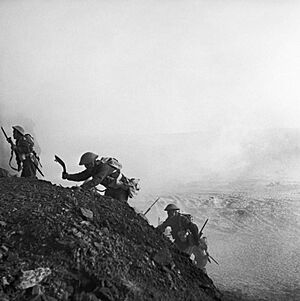
The US II Corps advanced again from the passes. They got behind the Axis lines. The German 10th Panzer Division counter-attacked at the Battle of El Guettar on March 23. The German tanks drove into a minefield. US artillery and anti-tank units opened fire. The 10th Panzer Division quickly lost 30 tanks and retreated. A second attack was also pushed back. The 10th Panzer Division returned to Gabès.
The US II Corps could not take advantage of the German failure. Each attack was stopped by German counter-attacks. Allied air and ground forces still did not work well together. The Eighth Army and the US II Corps attacked for the next week. On March 28, the Eighth Army captured El Hamma. This forced the Axis to abandon Gabès. They retreated north towards the Fifth Panzer Army. The hills in front of the US forces were abandoned. This allowed them to join the British forces in Gabès. The New Zealand and British armored divisions chased the Germans north. They pushed them into defensive positions in the hills west of Enfidaville. These positions were held until the end of the campaign.
Fighting in the North
On February 26, Arnim launched Operation Ochsenkopf ("Ox Head"). He mistakenly thought the Allies had weakened the north. This attack was against the British V Corps. The main attacks were by Corps Weber. This force had German infantry and tanks. They advanced in three groups. One group moved west towards Medjez el Bab. A second group moved southwest towards Béja. The third group pushed west south of Medjez. Another German division protected the northern flank. It tried to force the Allies out of their positions.
This attack made good progress across French-held hills. Costly counter-attacks by British and French forces delayed the Axis. French battalions moved to join another corps. This left little opposition to the Germans. As a result, the British abandoned Sedjenane on March 4. The British were slowly pushed back over the next three weeks.
Operation Ochsenkopf Battles
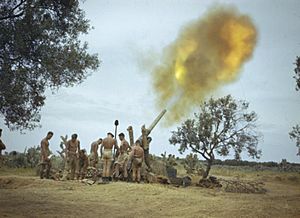
The main offensive, Ochsenkopf, led to fierce fighting. German forces were held up for a whole day by a small British force. This delay was very important. It allowed the British to prepare a strong defensive area at Hunts Gap. In the southern attack, German forces made some progress. But a British force was able to push them back. Two British Churchill tanks destroyed an entire German transport column. The final German attack was stopped at Hunt's Gap. British infantry, artillery, air cover, and tanks held the line.
Fighting lasted until March 5. In terrible weather, Arnim called off the operation. The Axis suffered heavy losses in soldiers and tanks. Many heavy Tiger Tanks were lost. Ochsenkopf was the last major Axis attack by the 5th Panzer Army. On March 25, Alexander ordered a counter-attack. On March 28, the British attacked. They recaptured all lost ground and took 850 German and Italian prisoners. On April 7, the British 78th Infantry Division cleared the Béja-Medjez road. They advanced 10 miles through difficult mountains. The 4th Infantry Division joined the fighting. They pushed towards Sidi Nsir.
Allied Victory in Tunisia
Allied Final Plans
The area around Medjez was now secure. Roads in the V Corps area were clear. Anderson could now focus on the big attack planned for April 22. The goal was to capture Tunis. By this time, Allied planes had moved to airfields in Tunisia. This helped stop Axis air supplies (Operation Flax). Many German transport planes were shot down. British destroyers from Malta stopped Axis sea supplies (Operation Retribution). Admiral Cunningham ordered his ships to "Sink, burn, capture, destroy. Let nothing pass." Very few Axis ships even tried to cross. By April 18, the Axis forces were pushed into a defensive line. They were on the northeast coast of Tunis. They had little hope of continuing the battle.
Alexander planned for the US II Corps to attack north towards Bizerte. The British First Army would attack towards Tunis. The Eighth Army would attack north from Enfidaville. Anderson would coordinate the First Army and US II Corps. His plan was for the main attack to be in the center. But the IX Corps would first attack northeast. They hoped to get behind the main Axis defenses. The US II Corps would make two pushes. One would capture high ground. The second would go towards Bizerte. The French XIX Corps would wait until the other attacks had drawn away the enemy.
The Final Battle
The Allied forces reorganized. On the night of April 19/20, the Eighth Army captured Enfidaville. The Italian forces counter-attacked several times but were pushed back. The Eighth Army's advance allowed the US II Corps to move to the northern end of the Allied front. Arnim knew an Allied attack was coming. He launched a surprise attack on the night of April 20/21. German forces pushed up to 5 miles into Allied lines. But they could not force a general retreat. They eventually returned to their lines. This attack did not seriously disrupt Allied plans.
On the morning of April 22, the British 46th Division attacked. They created a gap for the 6th Armoured Division to pass through. The 1st Armoured Division then struck east. But they were not fast enough to stop the Axis from setting up a strong anti-tank defense. This halted their progress. The battle had drawn Axis tank reserves south. This left the central front weaker. The British V Corps attack began on the evening of April 22. The US II Corps launched their attack on April 23. They captured Hill 609, which opened the way to Bizerte. In tough hand-to-hand fighting, the V Corps fought for eight days. They captured most of the Axis defensive positions.
The fighting was costly for both sides. But the Battle of Longstop Hill was captured. This opened the way to Tunis. Anderson felt a breakthrough was close. On April 30, it became clear that an Eighth Army attack from Enfidaville would not succeed. General Alexander gave the Eighth Army a holding task. He transferred several British divisions from the Eighth Army to the First Army.
The troop movements were finished by the night of May 5. Anderson arranged a fake tank concentration to trick the Axis. This helped surprise the Axis when the attack began. The final assault started at 3:30 a.m. on May 6. British V Corps made a preliminary attack on May 5. They captured high ground to protect the IX Corps' left side. British and Indian divisions broke through the defenses. This allowed the 6th and 7th Armoured divisions to pass through. On May 7, British tanks entered Tunis. American infantry from II Corps entered Bizerte.
Axis Surrender
Six days after Tunis and Bizerte fell, the last Axis resistance in Africa ended. Over 230,000 German and Italian soldiers surrendered. They became prisoners of war (POWs). US commanders reported that German resistance stopped on May 6. German troops began surrendering in large numbers. On May 8, the German 334th Division surrendered to British forces. On May 9, the US II Corps surrounded what was left of the 5th Panzer Army. They surrendered before noon. At least 12,000 Germans surrendered in one sector. Around 22,000 Germans also stopped fighting on May 11. They surrendered to the Free French.
British and Commonwealth forces reported taking 150,000 Axis POWs. The commander of the German 90th Light Division surrendered. Arnim surrendered to the British. Messe, commander of the Italian 1st Army, was still holding his line. On May 12, Mussolini ordered Messe to surrender. The next day, the Italian 1st Army was still fighting. But the remaining 80,000 men were surrounded. The RAF and artillery continued their bombardment. Around noon, the 1st Army surrendered to the Eighth Army. Messe formally surrendered to British and New Zealand forces.
Aftermath of the Campaign
Casualties and Losses
Allied Losses
Allied casualties were 76,020 soldiers. This includes losses from the British First Army and the Eighth Army. British and Commonwealth forces lost 38,360 men. Of these, 6,233 were killed, 21,528 were wounded, and 10,599 were missing. The Free French suffered 19,439 casualties. This included 2,156 killed, 10,276 wounded, and 7,007 missing. American casualties were 18,221 men. Of these, 2,715 were killed, 8,978 were wounded, and 6,528 were missing.
From November 22 to 30, 1942, the RAF flew 1,710 missions and lost at least 45 aircraft. The USAAF flew 180 missions and lost at least 7 planes. From December 1 to 12, the RAF lost at least 37 aircraft. The USAAF lost another 17 aircraft. From December 13 to 26, the RAF lost at least 20 planes. The USAAF lost 16 aircraft. From December 27, 1942, to January 17, 1943, the RAF lost 38 aircraft. The USAAF lost 36 planes. From January 18 to February 13, the RAF lost 34 aircraft. The USAAF lost 85. During the rest of February to March 28, 156 Allied planes were lost. Between March 29 and April 21, 203 Allied aircraft were destroyed. From April 22 to the end of the campaign, 45 bombers and 110 fighters were lost.
Axis Losses
The Axis armies suffered between 290,000 and 362,000 casualties. The exact numbers are not certain. It is estimated that the German army lost 8,500 men killed. The Italians lost 3,700 men killed. Another 40,000 to 50,000 Axis soldiers were wounded. The Allies took 238,243 unwounded prisoners. This included 101,784 Germans, 89,442 Italians, and 47,017 others. Some estimates say a quarter of a million prisoners were taken.
The German Air Force (Luftwaffe) lost over 2,422 aircraft in the Mediterranean from November 1942 to May 1943. At least 1,045 aircraft were destroyed. From November 22 to 30, 1942, the Luftwaffe lost 63 aircraft. The Italian Air Force lost 4. From December 1 to 12, the Luftwaffe lost 37 aircraft. The Italians lost 10 more. From December 13 to 26, the Luftwaffe lost 17 aircraft. The Italians lost 3. From December 27, 1942, to January 17, 1943, the Luftwaffe lost 47 planes. From January 18 to February 13, the Luftwaffe lost another 100 aircraft. From February 14 to March 28, 136 German planes were lost. The Italian Air Force lost 22 more. From March 29 to April 21, 270 Luftwaffe planes were destroyed. They also lost almost their entire remaining air transport fleet. From April 22 until the end, the Luftwaffe lost 273 aircraft. The Italians lost 17 planes. Over 600 Axis aircraft were captured by the Allies.
Images for kids
See also
- List of British military equipment of World War II
- List of equipment of the United States Army during World War II
- List of French military equipment of World War II
- List of German military equipment of World War II
- List of Italian Army equipment in World War II
- Tunisian Victory
- List of World War II Battles
- Military history of Italy during World War II
- Panzer Army Africa
- Italian Service Units
- US Naval Bases North Africa


